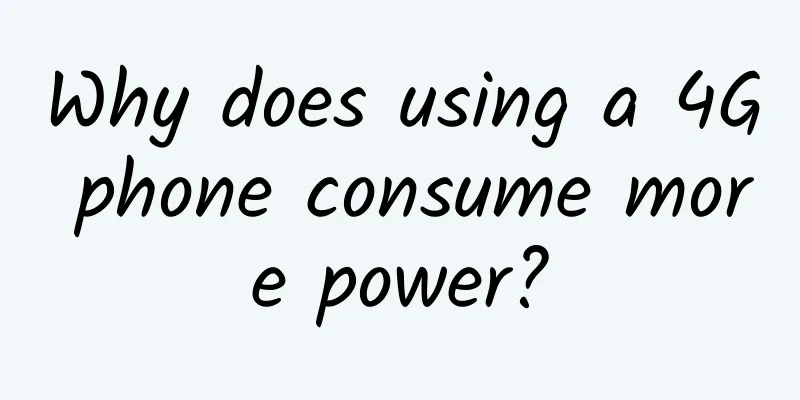Why does using a 4G phone consume more power?

|
According to technical principles, 4G network is a relatively power-saving signal. However, due to the incomplete construction of 4G base stations, factors such as signal strength and regional switching will hinder users' experience of using 4G network, which may cause users to feel that 4G network consumes more power. 1. The strength of the network signal will affect power consumption Not only 4G, but also any network mode will consume power when the phone encounters a poor signal. 4G consumes power because the 4G signal is not as good as the 3G signal, and 3G consumes power because the 3G signal is not as good as the 2G signal. According to tests, the current 4G network mobile phone consumes about 5% of power in standby mode for one hour, while the standby power consumption of 2G and 3G mobile phones is about 2%. When the mobile phone is working, the power consumption of each network is also significantly different. The 2G power control frequency is lower, the peak-to-average ratio is lower when no data service is turned on, and the power consumption is less. During the technical upgrade process, 3G networks use a lot of modulation above 16QAM, which has a certain peak-to-average ratio and a higher overall power consumption than 2G. However, 3G has a better control rate, so the power consumption is not too large during operation. The biggest problem with 4G networks at present is that orthogonal frequency division multiplexing modulation will cause an uncontrollable peak-to-average ratio, so 4G has the highest power consumption. 2. The distance between the terminal and the base station affects power consumption In addition, the distance between the terminal and the base station will also affect power consumption. 2G GSM base stations have the highest density, wide coverage, and low frequency band, so the overall mobile phone power is lower. The coverage rate of 3G network base stations is also high, so the signal of 3G network is also smooth. However, due to the imperfect construction of 4G network in China, especially the limited coverage of 4G base stations of China Unicom and China Telecom, the 4G signal is weak in some areas. If you use 4G network in this case, the mobile network may switch back and forth between 4G and 3G, which will increase the power consumption. Therefore, when users upgrade to 4G network, it is best to first confirm whether the area is covered by 4G network, and choose to use 4G network in areas with strong 4G signal. If the network signal is not good, it is best to choose to turn off the 4G network function to save power. Once all objective factors stabilize and the 4G network has full coverage, users will save a lot of power when using the 4G network. As a winner of Toutiao's Qingyun Plan and Baijiahao's Bai+ Plan, the 2019 Baidu Digital Author of the Year, the Baijiahao's Most Popular Author in the Technology Field, the 2019 Sogou Technology and Culture Author, and the 2021 Baijiahao Quarterly Influential Creator, he has won many awards, including the 2013 Sohu Best Industry Media Person, the 2015 China New Media Entrepreneurship Competition Beijing Third Place, the 2015 Guangmang Experience Award, the 2015 China New Media Entrepreneurship Competition Finals Third Place, and the 2018 Baidu Dynamic Annual Powerful Celebrity. |
>>: Dan Nystedt: Nvidia will contribute 11% of TSMC's revenue in 2023
Recommend
How much does it cost to develop a Chaohu children's clothing mini program? What is the price for customizing Chaohu children's clothing through the mini program?
Is it easy to be an agent of Chaohu children'...
How to use the mother and baby mini program? How to promote the maternal and child mini program mall?
After the country relaxed the "three-child p...
Man Jiang Hong, what is red?
A River Full of Red: Writing Thoughts (Song Dynas...
Video websites once again break out of the competition and welcome the first year of online dramas
After purchasing genuine copyrights, introducing ...
There is a bird called "Long-necked Waiting Bird"...so what is it waiting for?
I believe that people living in Beijing are famil...
A must-have for operations, promotion and marketing: a complete list of the latest hot topics in July 2017!
Nowadays, chasing hot topics has become one of th...
A first look at Swift 2.0: Notable new features
In the blink of an eye, Swift is already over a y...
Apple iOS 15 leak summary: In addition to new icons, new lock screen, new notifications, there are 3 major changes
If you are a qualified Apple fan, even if there a...
Students use ChatGPT to do homework? Chinese professor posted on Natuer: Encourage, but do it this way
Source: Nature Original author: Hong Yang, Profes...
How much RMB is equivalent to 1 US dollar? Real-time quotes of USD/RMB exchange rate today, July 23, 2020
How much RMB is equivalent to 1 US dollar? Today&...
An anonymous source revealed how ASO Himalaya was created
An anonymous source revealed how ASO Himalaya was...
Alipay Ant Forest, does it have a product operation routine?
This article mainly conducts a detailed analysis ...
Yiche Ranking: Top 20 first-registered private car brands in Hong Kong, China, in November 2024
Yiche.com released the top 20 list of first-time ...
What are the characteristics of the materials with high click-through rates on Fanstong and Guangdiantong?
Based on the front-end delivery and back-end conv...
How do you monetize your product? Here are 3 channels to help you sort out
As dividends disappear and capital returns to rat...
![[APP Promotion] How to promote and operate a new App?](/upload/images/67cc450d3c6c1.webp)








